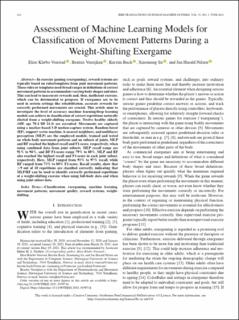| dc.description.abstract | In exercise gaming (exergaming), reward systems are typically based on rules/templates from joint movement patterns. These rules or templates need broad ranges in definitions of correct movement patterns to accommodate varying body shapes and sizes. This can lead to inaccurate rewards and, thus, inefficient exercise, which can be detrimental to progress. If exergames are to be used in serious settings like rehabilitation, accurate rewards for correctly performed movements are crucial. This article aims to investigate the level of accuracy machine learning/deep learning models can achieve in classification of correct repetitions naturally elicited from a weight-shifting exergame. Twelve healthy elderly (10F, age 70.4 SD 11.4) are recruited. Movements are captured using a marker-based 3-D motion-capture system. Random forest (RF), support vector machine, k-nearest neighbors, and multilayer perceptron (MLP) are the employed models, trained and tested on whole body movement patterns and on subsets of joints. MLP and RF reached the highest recall and F1-score, respectively, when using combined data from joint subsets. MLP recall range are 91% to 94%, and RF F1-score range 79% to 80%. MLP and RF also reached the highest recall and F1-score in each joint subset, respectively. Here, MLP ranged from 93% to 97% recall, while RF ranged from 73% to 80% F1-score. Recall results, show that >9 out of 10 repetitions are classified correctly, indicating that MLP/RF can be used to identify correctly performed repetitions of a weight-shifting exercise when using full-body data and when using joint subset data. | en_US |

